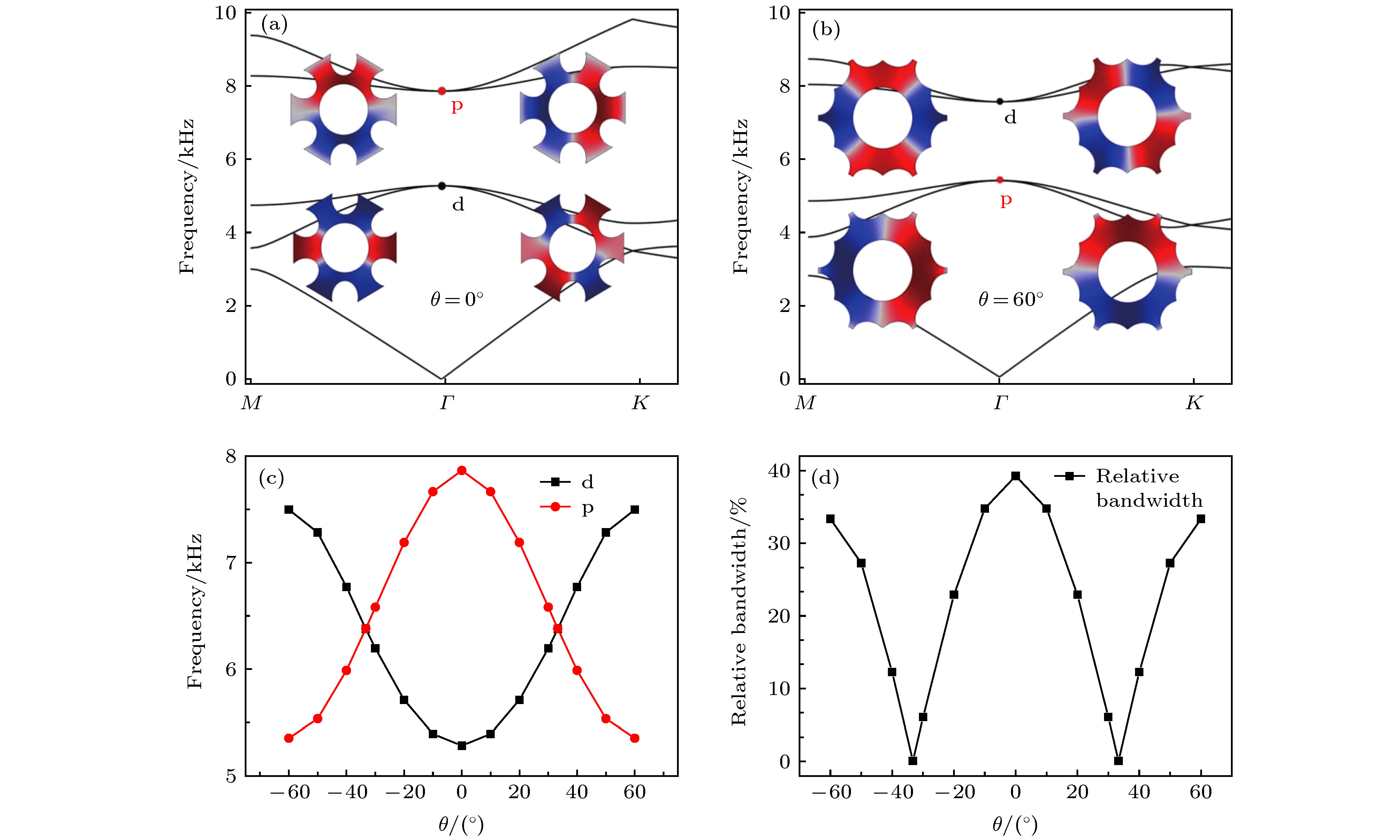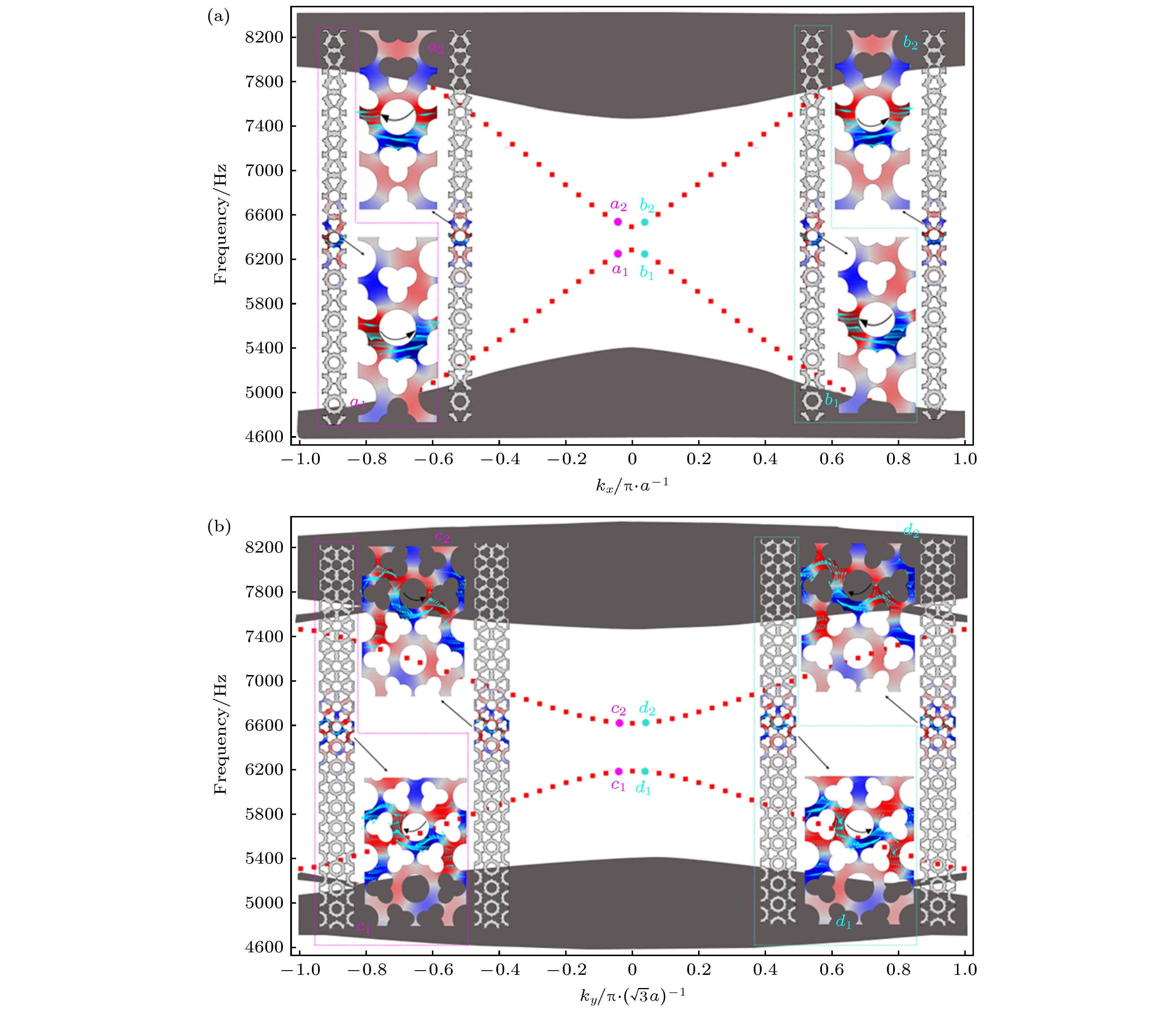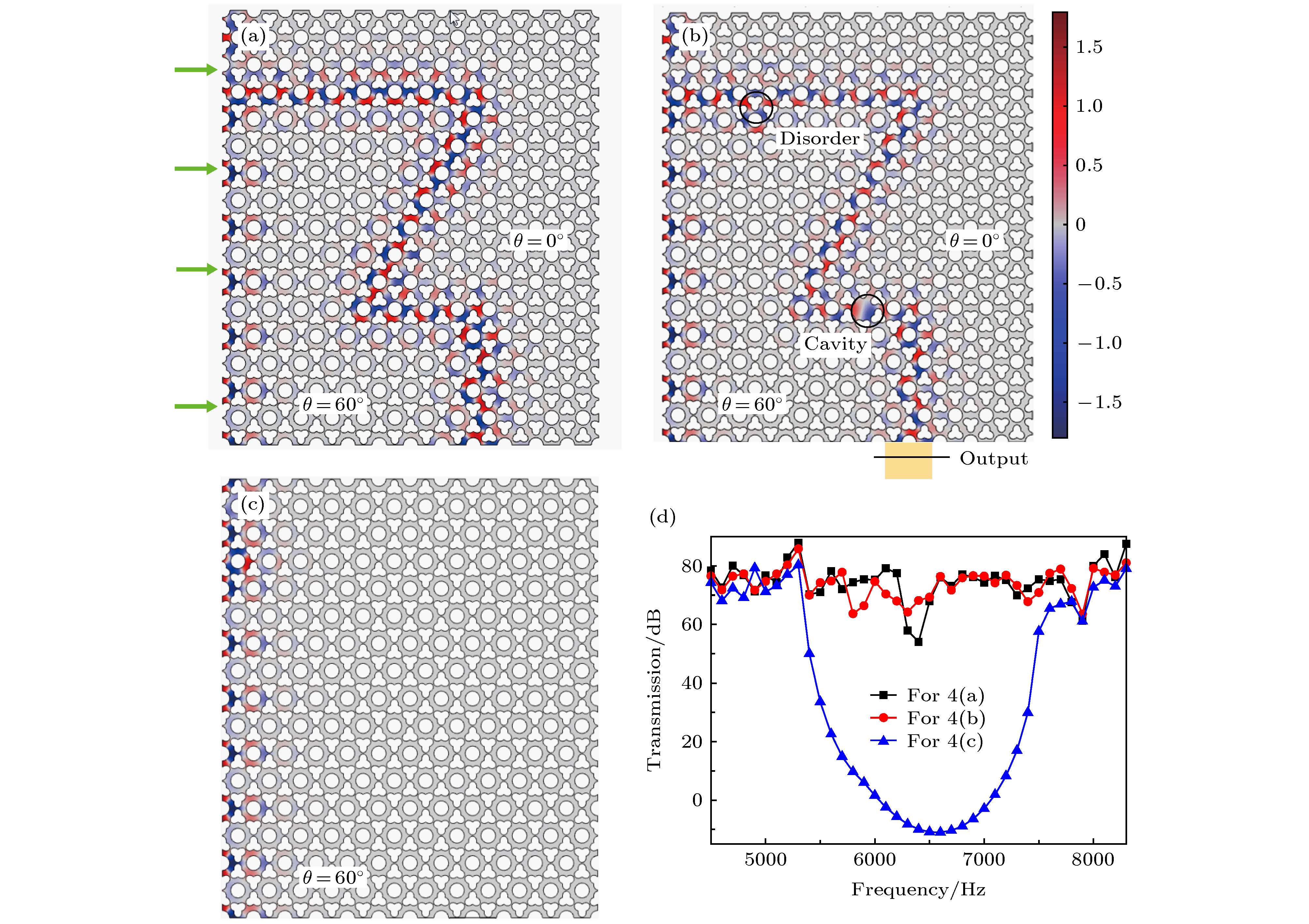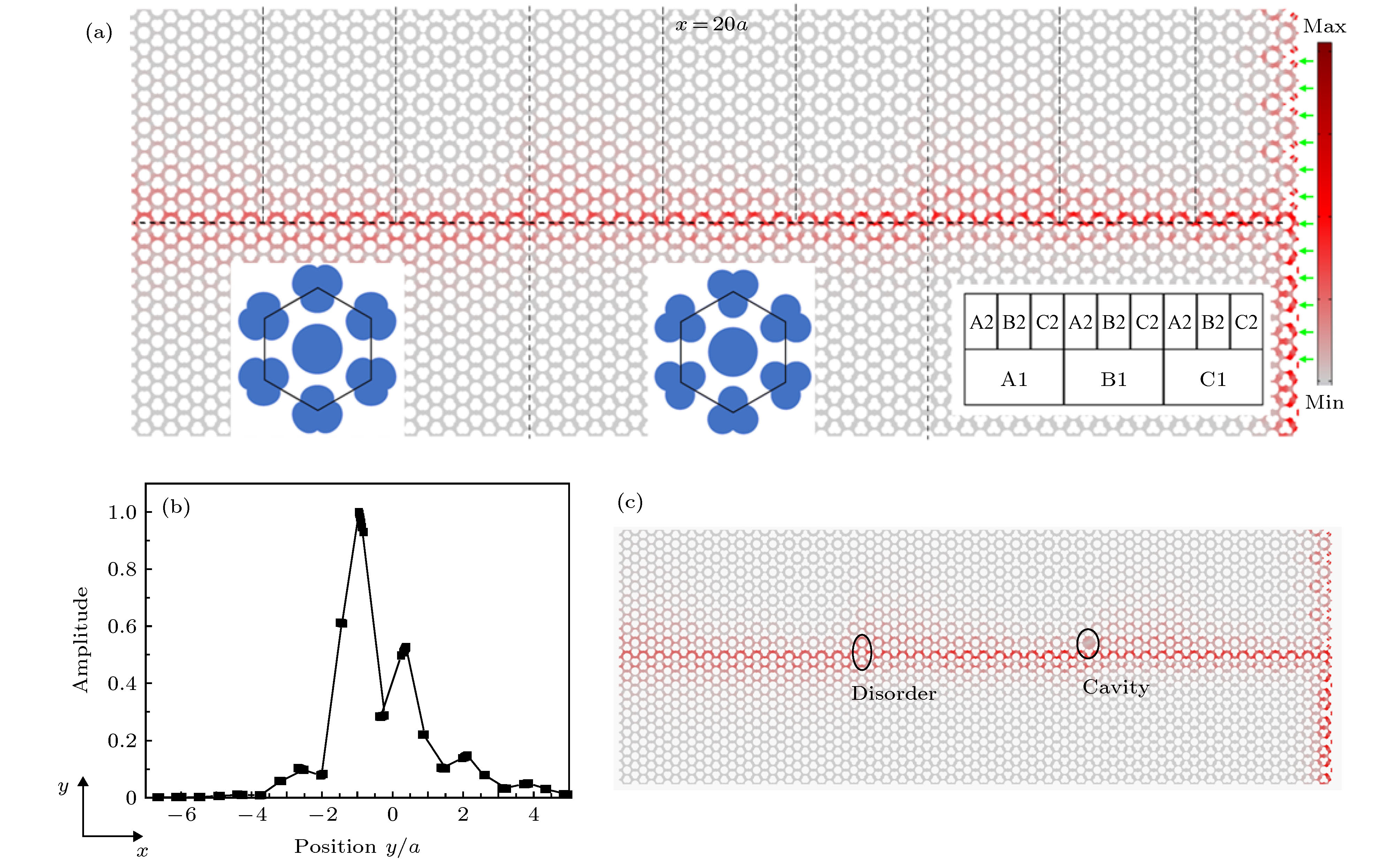-
具有良好可重构性、良好缺陷兼容性及紧凑型的声学拓扑结构可能成为声学发展中一个有前景的方向. 本文设计了一种可调谐、应用于空气声的二维宽带复合蜂窝形晶格结构, 其元胞拥有两个变量: 一个是中心圆的缩放参数s, 另一个是“花瓣”图案围绕其质心的旋转角度θ. 研究发现当s为1.2, θ为±33°时, 在结构的布里渊区中心点出现四重简并态. 在±33°两侧, 能带会发生反转, 体系经历拓扑相变; 同时, 结构的相对带隙宽带逐渐增加, 其中θ为0°和60°时, 相对带宽分别为0.39和0.33. 本研究还计算了由这两种转角的声子晶体组成的拼合结构的投影能带, 发现在其体带隙中存在着边界态并验证了此拓扑边界的缺陷免疫特性. 最后通过变化s, 构建了一种非周期性双狄拉克锥型的声拓扑绝缘体并验证了其缺陷免疫性. 本研究的体系相对带宽显著超过已知体系, 将为利用声拓扑边界的声波器件微型化打下良好的基础.
-
关键词:
- 拓扑相变 /
- 宽带结构 /
- 非周期双狄拉克锥拓扑绝缘体
The discovery of quantum Hall effect and quantum spin Hall effect has set off a new research upsurge in condensed matter physics. As is analogous to electronic systems, many novel optical and acoustic control devices have been designed by using the defects- immune and backscatter suppression of topological edges in photonic crystals and phononic crystals, which greatly enriches the current physical world and arouses more research enthusiasm. With the study of acoustic topological structure, it has been found that the realization of good reconfigurability, good compatibility against manufacturing defects, and compact acoustic topological insulators may become a promising development direction. This imposes higher requirements on the topological band gap width of the current acoustic topological structure. At the same time, the restriction on the using of the same primitive unit cells in previous researches does not reveal the implementation of aperiodic double Dirac cone topological insulators. Here in this work we present a tunable, two-dimensional broadband composite honeycomb lattice structure for airborne sound. Firstly, We construct a hexagonal structure and then take a circle with a radius of r1 in the center. Then the circle is anisotropically scaled with the scaling factor s, which means that the x direction of the circle is expanded by$\sqrt s $ times, and the y direction is reduced by$1/\sqrt s $ times to form an ellipse. Then, we perform a translation and rotation transformation on the ellipse, and finally construct a “triangular-like” petal pattern at each vertex of the hexagon. Secondly, we place a circle with a radius of r2 in the center to achieve the unit cell of the phononic crystal. This cell has two variables. One is the rotation angle θ of the petal pattern around its centroid, and the other is the scaling factor s. We find that there is a quadruple degenerate state at Γ with s = 1.2 and θ = ±33°. On both sides of ±33°, changing θ will induce an inverted band and a topological phase transition. At the same time, the relative band gap of the structure increases gradually. When θ is 0° and 60°, the structures are two topologically distinct broadband phononic crystals with relative band widths of 0.39 and 0.33, respectively. Calculated by the finite element software Comsol, the edge states existing in the band gap are found, and the backscattering immunity characteristics of the topological edges to defects such as right angle, Z-angle, disorder, and cavity are confirmed. For the first time we construct a aperiodic double Dirac cone acoustic topological insulators with different values of s and change their defect immunity. The research system is rich in function, and its relative bandwidth can even exceed 0.5 for a certain s value, which significantly exceeds the bandwidth of the known structure, and lays a good foundation for miniaturized acoustic wave devices taking full advantage of acoustic topological edges. Meanwhile, the realization of aperiodic topological insulators shows that the system can be used more flexibly for acoustic structure design.-
Keywords:
- topological phase transition /
- broadband structure /
- aperiodic double Dirac cone topological insulator
[1] Gusynin V P, Sharapov S G 2005 Phys. Rev. Lett. 95 146801
 Google Scholar
Google Scholar
[2] Zhang Y, Tan Y W, Stormer H L, Kim P 2005 Nature 438 201
 Google Scholar
Google Scholar
[3] Peres N M R, Guinea F, Neto A C 2006 Phys. Rev. B 73 125411
 Google Scholar
Google Scholar
[4] Privman V, Vagner I D, Kventsel G 1998 Phys. Lett. A 239 141
 Google Scholar
Google Scholar
[5] Klitzing K V, Dorda G, Pepper M 1980 Phys. Rev. Lett. 45 494
 Google Scholar
Google Scholar
[6] Laughlin R B 1983 Phys. Rev. Lett. 50 1395
 Google Scholar
Google Scholar
[7] Kane C L, Mele E J 2004 Phys. Rev. Lett. 95 226801
[8] Bernevig B A, Zhang S C 2006 Phys. Rev. Lett. 96 106802
 Google Scholar
Google Scholar
[9] Kosterlitz J M, Thouless D J 1972 Solid State Phys. 5 L124
 Google Scholar
Google Scholar
[10] Kosterlitz J M, Thouless D J 1973 Solid State Phys. 6 1181
 Google Scholar
Google Scholar
[11] Yu R, Zhang W, Zhang H J, Zhang S C, Dai X, Fang Z 2010 Science 329 61
 Google Scholar
Google Scholar
[12] Hasan M Z, Kane C L 2010 Rev. Mod. Phys. 82 3045
 Google Scholar
Google Scholar
[13] Shen S Q, Shan W Y, Lu H Z 2011 Spin 1 33
 Google Scholar
Google Scholar
[14] 田源, 葛浩, 卢明辉, 陈延峰 2019 物理学报 68 194301
 Google Scholar
Google Scholar
Tian Y, Ge H, Lu M H, Chen Y F 2019 Acta Phys. Sin. 68 194301
 Google Scholar
Google Scholar
[15] Wang Z, Chong Y D, Joannopoulos J D, Soljacic M 2008 Phys. Rev. Lett. 100 013905
 Google Scholar
Google Scholar
[16] Raghu S, Haldane F D M 2008 Phys. Rev. A 78 033834
 Google Scholar
Google Scholar
[17] Ochiai T, Onoda M 2009 Phys. Rev. B 80 155103
 Google Scholar
Google Scholar
[18] Gao F, Gao Z, Shi X, Yang Z, Lin X, Xu H, Chong Y, Soljačić M, Chen H, Lu L, Zhang B 2016 Nat. Commun. 7 11619
 Google Scholar
Google Scholar
[19] Peano V, Brendel C, Schmidt M, Marquardt F 2015 Phys. Rev. X 5 031011
[20] Gao W, Lawrence M, Yang B, Liu F, Fang F, Béri B, Li J, Zhang S 2015 Phys. Rev. Lett. 114 037402
 Google Scholar
Google Scholar
[21] Ma T, Khanikaev A B, Mousavi S H, Shvets G 2015 Phys. Rev. Lett. 114 127401
 Google Scholar
Google Scholar
[22] Hafezi M, Mittal S, Fan J, Migdall A, Taylor J M 2013 Nat. Photonics 7 1001
 Google Scholar
Google Scholar
[23] Khanikaev A B, Mousavi S H, Tse W K, Kargarian M, MacDonald A H, Shvets G 2013 Nat. Mater. 12 233
 Google Scholar
Google Scholar
[24] Wu L H, Hu X 2015 Phys. Rev. Lett. 114 223901
 Google Scholar
Google Scholar
[25] Ni X, He C, Sun X C, Liu X. P, Lu M H, Feng L, Chen Y F 2015 New J. Phys. 17 053016
[26] Yang Z, Gao F, Shi X, Lin X, Gao Z, Chong Y, Zhang B 2015 Phys. Rev. Lett. 114 114301
 Google Scholar
Google Scholar
[27] Chen Z G, Wu Y 2016 Phys. Rev. Appl. 5 054021
 Google Scholar
Google Scholar
[28] Peng Y G, Qin C Z, Zhao D G, Shen Y X, Xu X Y, Bao M, Jia H, Zhu X F 2016 Nat. Commun. 7 13368
 Google Scholar
Google Scholar
[29] Peng Y G, Shen Y X, Zhao D G, Zhu X F 2017 Appl. Phys. Lett. 110 173505
 Google Scholar
Google Scholar
[30] Peng Y G, Geng Z G, Zhu X F 2018 J. Appl. Phys. 123 091716
 Google Scholar
Google Scholar
[31] Lu J, Qiu C, Ye L, Fan X, Ke M, Zhang F, Liu Z 2017 Nat. Phys. 13 369
 Google Scholar
Google Scholar
[32] Lu J, Qiu C, Deng W, Huang X, Li F, Zhang F, Liu Z 2018 Phys. Rev. Lett. 120 116802
 Google Scholar
Google Scholar
[33] Dai H, Jiao J, Xia B, Liu T, Zheng S, Yu D 2018 J. Phys. D: Appl. Phys. 51 175302
 Google Scholar
Google Scholar
[34] Xia B Z, Liu T T, Huang G L, Dai H Q, Jiao J R, Zang X G, Yu D J, Zheng S J, Liu J 2017 Phys. Rev. B 96 094106
 Google Scholar
Google Scholar
[35] Geng Z G, Peng Y G, Shen Y X, Zhao D G, Zhu X F 2018 Appl. Phys. Lett. 113 033503
 Google Scholar
Google Scholar
[36] Geng Z G, Peng Y G, Li P Q, Shen Y X, Zhao D G, Zhu X F 2019 J. Phys.Condens. Matter 31 245403
 Google Scholar
Google Scholar
[37] Zhang Z, Wei Q, Cheng Y, Zhang T, Wu D, Liu X 2017 Phys. Rev. Lett. 118 084303
 Google Scholar
Google Scholar
[38] Deng Y, Ge H, Tian Y, Lu M, Jing Y 2017 Phys. Rev. B 96 184305
 Google Scholar
Google Scholar
[39] Zhang Z, Tian Y, Cheng Y, Liu X, Christensen J 2017 Phys. Rev. B 96 241306
 Google Scholar
Google Scholar
[40] Zhang Z, Tian Y, Cheng Y, Wei Q, Liu X, Christensen J 2018 Phys. Rev. Appl. 9 034032
 Google Scholar
Google Scholar
[41] Xia J P, Jia D, Sun H X, Yuan S Q, Ge Y, Si Q R, Liu X J 2018 Adv. Mater. 30 1805002
 Google Scholar
Google Scholar
[42] Mei J, Chen Z, Wu Y 2016 Sci. Rep. 6 32752
 Google Scholar
Google Scholar
[43] Dai H, Qian M, Jiao J, Xia B, Yu D 2018 J. Appl. Phys. 124 175107
 Google Scholar
Google Scholar
[44] Han X, Peng Y G, Li L, Hu Y, Mei C, Zhao D G, Zhu X F, Wang X 2019 Phys. Rev. Appl. 12 014046
 Google Scholar
Google Scholar
-
图 1 (a)正六边形表示晶格的元胞, 其中a1, a2是晶格基矢. 在六边形顶点的蓝色“花瓣”形结构与位于中心的圆形结构表示位于空气中的硬质散射体; (b)晶格的最简布里渊区Γ-M-K; (c)晶格结构的示意图
Fig. 1. (a) The hexagon represents the cell of the lattice, where a1, a2 is the lattice basis vector, the blue “petal” shape at the apex of the hexagon and the circular structure at the center represent the hard scatterers surrounded by air; (b) the irreducible Brillouin zone Γ-M-K; (c) schematic diagram of crystal structure.
图 2 CHL不同转角时的频带图与其拓扑相变 (a) θ = 0°, 其中下面两幅插图表示d态的声压场分布, 上面两幅插图表示p态的声压场分布; (b) θ = 60°, 插图表示p, d态的声压场分布; (c)结构的拓扑相图, 表示随着转角变化, 频带发生反转; (d)不同转角下带隙的相对带宽
Fig. 2. The band structures with different θ and its topological phase transition of the CHL: (a) θ = 0°, in which the lower two illustrations show the sound pressure field distribution of the d state, and the upper two illustrations show the sound pressure field distribution of the p state; (b) θ = 60°, in which the upper and lower illustrations show the sound pressure field distribution of the d and p states, respectively; (c) the topological phase diagram of the structure, indicating that the frequency band is reversed as the rotation angle changes; (d) the relative bandwidth of the band gap at different θ.
图 3 (a) Ⅰ型边界沿kx方向的投影带结构, 图中的灰色区域表示体态, 红色点线表示边界态, 两侧插图表示θ = 60°的5层平庸型声子晶体与θ = 0°的5层非平庸型声子晶体沿着ky方向拼接起来, 构成的超胞及a1, a2, b1, b2点的声压分布; (b) Ⅱ型边界沿ky方向的投影带结构, 两侧插图表示θ = 60°的10层平庸型声子晶体与θ = 0°的10层非平庸型声子晶体沿着kx方向拼接起来, 构成的超胞及c1, c2, d1, d2点的声压分布, 插图中的黑色弧形箭头表示边界处的能流方向
Fig. 3. (a) The projection band structure of the type I edge along the kx direction. The gray area in the figure represents the bulk state, and the red dotted line represents the edge state. The illustrations on both sides indicate that the five-layer trivial phononic crystal with θ = 60° and the five-layer nontrivial phononic crystal with θ = 0° are spliced along the ky direction to form the supercell and the sound pressure distribution at a1, a2, b1, b2; (b) the projection band structure of the type II edge along the ky direction. The illustrations on both sides indicate that a 10-layer trivial phononic crystal with θ = 60° and a 10-layer nontrivial phononic crystal with θ = 0° are spliced together in the kx direction to form the supercell and the sound pressure distribution at points c1, c2, d1, d2. The black curved arrow in the illustration indicates the energy flow direction at the edge.
图 4 幅值为1, f = 6900 Hz的平面波从左侧入时结构的声压分布及透射谱 (a)由θ = 60°与θ = 0°的声子晶体的拼接结构组成的混合声子晶体, 两种声子晶体的相接触的边界称为拓扑边界, 左侧的青色箭头表示平面波入射, 从图中声压分布可以看出: 声波能够绕过直角与Z形角沿着边界进行传播; (b)在图(a)的基础上继续引入乱序与缺失的缺陷, 声波依然能够绕过这些缺陷传播; (c)由θ = 60°声子晶体单独构成的结构, 声波不能传播; (d)图(a)—图(c)结构的声强透射谱
Fig. 4. The sound pressure distribution and transmission spectrum of the structure when a plane wave is incident from the left side with amplitude 1 Pa and f = 6900 Hz: (a) A mixed phononic crystal composed of a spliced structure of phononic crystals with θ = 60° and θ = 0°, and the edge between the two phononic crystals is called the topological edge. The cyan arrow on the left side indicates the plane wave incidence. It can be seen from the sound pressure distribution that the sound wave can propagate around the right angle and the Z-angle along the edge; (b) introduce disorder and cavity on the basis of Fig. (a), sound waves can still propagate around these defects; (c) a structure consisted of phononic crystals with θ = 60° alone where sound waves cannot propagate; (d) sound intensity transmission spectra of the structures of Fig. (a)—Fig. (c).
图 5 (a) Γ处d, p态对应的频率值随s的变化情况; (b) s = 0.8时结构的拓扑相图; (c) s = 1.2时结构的拓扑相图
Fig. 5. (a) The frequency corresponding to the d and p states with the changes of the parameter s at Γ; (b) the topological phase diagram of the structure at s = 0.8; (c) the topological phase diagram of the structure at s = 1.2.
图 6 非周期拓扑绝缘体结构的声压分布 (a)为由s为0.8, 1.0, 1.2三种声子晶体构造的非周期声拓扑绝缘体组成及其在右侧f = 6900 Hz声波入射下的声压幅值分布. 中间的横虚线表示水平拼接位置, 竖虚线表示竖直拼接位置, 第一、二幅插图代表θ为0°, s为0.8, 1.0时, 晶格的元胞. 三种声子晶体的具体位置如第三幅插图所示, 其中A, B, C分别表示s为0.8, 1.0, 1.2三种结构, 数字1, 2分别代表θ为0°, 60°两种不同的转角, 右侧的青色箭头代表平面波入射; (b)表示x = 20a处沿着y方向的声压幅值分布, 其值经过最大值归一化; (c)在图(a)的基础上进一步引入乱序与缺失的缺陷时结构声压幅值的分布
Fig. 6. Sound pressure distribution of aperiodic topological insulator structure: (a) A periodic acoustic topological insulator composed of three phononic crystal structures with s = 0.8, 1.0, and 1.2 and its sound pressure amplitude distribution when sound wave with f = 6900 Hz is incident from the right side. The horizontal dashed line in the middle indicates the horizontal stitching position, and the vertical dashed line indicates the vertical stitching position. The first and second insets represent the lattice cells with θ = 0° and s of 0.8 and 1.0, respectively. The specific positions of the three phononic crystals are shown in the third illustration, where A, B, and C respectively represent s = 0.8, 1.0, and 1.2, and the numbers 1 and 2 represent θ = 0° and 60°, respectively. The cyan arrow on the right indicates the incident plane wave; (b) the sound pressure amplitude distribution along the y direction at x = 20a, and its value is normalized by the maximum value; (c) the distribution of the sound pressure amplitude when introducing disorder and cavity on the basis of Fig. (a).
-
[1] Gusynin V P, Sharapov S G 2005 Phys. Rev. Lett. 95 146801
 Google Scholar
Google Scholar
[2] Zhang Y, Tan Y W, Stormer H L, Kim P 2005 Nature 438 201
 Google Scholar
Google Scholar
[3] Peres N M R, Guinea F, Neto A C 2006 Phys. Rev. B 73 125411
 Google Scholar
Google Scholar
[4] Privman V, Vagner I D, Kventsel G 1998 Phys. Lett. A 239 141
 Google Scholar
Google Scholar
[5] Klitzing K V, Dorda G, Pepper M 1980 Phys. Rev. Lett. 45 494
 Google Scholar
Google Scholar
[6] Laughlin R B 1983 Phys. Rev. Lett. 50 1395
 Google Scholar
Google Scholar
[7] Kane C L, Mele E J 2004 Phys. Rev. Lett. 95 226801
[8] Bernevig B A, Zhang S C 2006 Phys. Rev. Lett. 96 106802
 Google Scholar
Google Scholar
[9] Kosterlitz J M, Thouless D J 1972 Solid State Phys. 5 L124
 Google Scholar
Google Scholar
[10] Kosterlitz J M, Thouless D J 1973 Solid State Phys. 6 1181
 Google Scholar
Google Scholar
[11] Yu R, Zhang W, Zhang H J, Zhang S C, Dai X, Fang Z 2010 Science 329 61
 Google Scholar
Google Scholar
[12] Hasan M Z, Kane C L 2010 Rev. Mod. Phys. 82 3045
 Google Scholar
Google Scholar
[13] Shen S Q, Shan W Y, Lu H Z 2011 Spin 1 33
 Google Scholar
Google Scholar
[14] 田源, 葛浩, 卢明辉, 陈延峰 2019 物理学报 68 194301
 Google Scholar
Google Scholar
Tian Y, Ge H, Lu M H, Chen Y F 2019 Acta Phys. Sin. 68 194301
 Google Scholar
Google Scholar
[15] Wang Z, Chong Y D, Joannopoulos J D, Soljacic M 2008 Phys. Rev. Lett. 100 013905
 Google Scholar
Google Scholar
[16] Raghu S, Haldane F D M 2008 Phys. Rev. A 78 033834
 Google Scholar
Google Scholar
[17] Ochiai T, Onoda M 2009 Phys. Rev. B 80 155103
 Google Scholar
Google Scholar
[18] Gao F, Gao Z, Shi X, Yang Z, Lin X, Xu H, Chong Y, Soljačić M, Chen H, Lu L, Zhang B 2016 Nat. Commun. 7 11619
 Google Scholar
Google Scholar
[19] Peano V, Brendel C, Schmidt M, Marquardt F 2015 Phys. Rev. X 5 031011
[20] Gao W, Lawrence M, Yang B, Liu F, Fang F, Béri B, Li J, Zhang S 2015 Phys. Rev. Lett. 114 037402
 Google Scholar
Google Scholar
[21] Ma T, Khanikaev A B, Mousavi S H, Shvets G 2015 Phys. Rev. Lett. 114 127401
 Google Scholar
Google Scholar
[22] Hafezi M, Mittal S, Fan J, Migdall A, Taylor J M 2013 Nat. Photonics 7 1001
 Google Scholar
Google Scholar
[23] Khanikaev A B, Mousavi S H, Tse W K, Kargarian M, MacDonald A H, Shvets G 2013 Nat. Mater. 12 233
 Google Scholar
Google Scholar
[24] Wu L H, Hu X 2015 Phys. Rev. Lett. 114 223901
 Google Scholar
Google Scholar
[25] Ni X, He C, Sun X C, Liu X. P, Lu M H, Feng L, Chen Y F 2015 New J. Phys. 17 053016
[26] Yang Z, Gao F, Shi X, Lin X, Gao Z, Chong Y, Zhang B 2015 Phys. Rev. Lett. 114 114301
 Google Scholar
Google Scholar
[27] Chen Z G, Wu Y 2016 Phys. Rev. Appl. 5 054021
 Google Scholar
Google Scholar
[28] Peng Y G, Qin C Z, Zhao D G, Shen Y X, Xu X Y, Bao M, Jia H, Zhu X F 2016 Nat. Commun. 7 13368
 Google Scholar
Google Scholar
[29] Peng Y G, Shen Y X, Zhao D G, Zhu X F 2017 Appl. Phys. Lett. 110 173505
 Google Scholar
Google Scholar
[30] Peng Y G, Geng Z G, Zhu X F 2018 J. Appl. Phys. 123 091716
 Google Scholar
Google Scholar
[31] Lu J, Qiu C, Ye L, Fan X, Ke M, Zhang F, Liu Z 2017 Nat. Phys. 13 369
 Google Scholar
Google Scholar
[32] Lu J, Qiu C, Deng W, Huang X, Li F, Zhang F, Liu Z 2018 Phys. Rev. Lett. 120 116802
 Google Scholar
Google Scholar
[33] Dai H, Jiao J, Xia B, Liu T, Zheng S, Yu D 2018 J. Phys. D: Appl. Phys. 51 175302
 Google Scholar
Google Scholar
[34] Xia B Z, Liu T T, Huang G L, Dai H Q, Jiao J R, Zang X G, Yu D J, Zheng S J, Liu J 2017 Phys. Rev. B 96 094106
 Google Scholar
Google Scholar
[35] Geng Z G, Peng Y G, Shen Y X, Zhao D G, Zhu X F 2018 Appl. Phys. Lett. 113 033503
 Google Scholar
Google Scholar
[36] Geng Z G, Peng Y G, Li P Q, Shen Y X, Zhao D G, Zhu X F 2019 J. Phys.Condens. Matter 31 245403
 Google Scholar
Google Scholar
[37] Zhang Z, Wei Q, Cheng Y, Zhang T, Wu D, Liu X 2017 Phys. Rev. Lett. 118 084303
 Google Scholar
Google Scholar
[38] Deng Y, Ge H, Tian Y, Lu M, Jing Y 2017 Phys. Rev. B 96 184305
 Google Scholar
Google Scholar
[39] Zhang Z, Tian Y, Cheng Y, Liu X, Christensen J 2017 Phys. Rev. B 96 241306
 Google Scholar
Google Scholar
[40] Zhang Z, Tian Y, Cheng Y, Wei Q, Liu X, Christensen J 2018 Phys. Rev. Appl. 9 034032
 Google Scholar
Google Scholar
[41] Xia J P, Jia D, Sun H X, Yuan S Q, Ge Y, Si Q R, Liu X J 2018 Adv. Mater. 30 1805002
 Google Scholar
Google Scholar
[42] Mei J, Chen Z, Wu Y 2016 Sci. Rep. 6 32752
 Google Scholar
Google Scholar
[43] Dai H, Qian M, Jiao J, Xia B, Yu D 2018 J. Appl. Phys. 124 175107
 Google Scholar
Google Scholar
[44] Han X, Peng Y G, Li L, Hu Y, Mei C, Zhao D G, Zhu X F, Wang X 2019 Phys. Rev. Appl. 12 014046
 Google Scholar
Google Scholar
计量
- 文章访问数: 11652
- PDF下载量: 186
- 被引次数: 0
















 下载:
下载:






